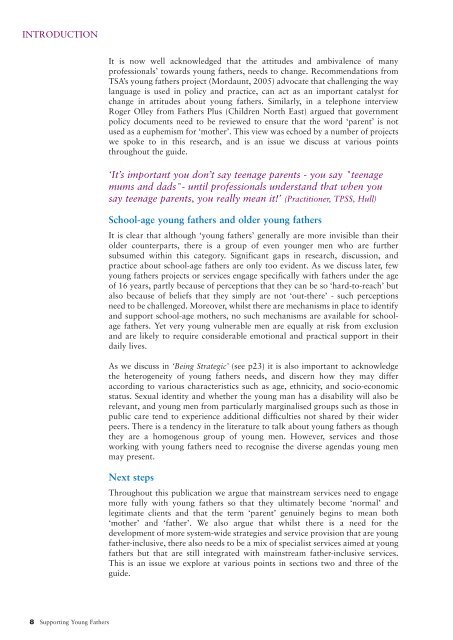TOP TIP - University of Brighton Repository
TOP TIP - University of Brighton Repository
TOP TIP - University of Brighton Repository
You also want an ePaper? Increase the reach of your titles
YUMPU automatically turns print PDFs into web optimized ePapers that Google loves.
INTRODUCTION<br />
8<br />
Supporting Young Fathers<br />
It is now well acknowledged that the attitudes and ambivalence <strong>of</strong> many<br />
pr<strong>of</strong>essionals’ towards young fathers, needs to change. Recommendations from<br />
TSA’s young fathers project (Mordaunt, 2005) advocate that challenging the way<br />
language is used in policy and practice, can act as an important catalyst for<br />
change in attitudes about young fathers. Similarly, in a telephone interview<br />
Roger Olley from Fathers Plus (Children North East) argued that government<br />
policy documents need to be reviewed to ensure that the word ‘parent’ is not<br />
used as a euphemism for ‘mother’. This view was echoed by a number <strong>of</strong> projects<br />
we spoke to in this research, and is an issue we discuss at various points<br />
throughout the guide.<br />
‘It’s important you don’t say teenage parents - you say "teenage<br />
mums and dads"- until pr<strong>of</strong>essionals understand that when you<br />
say teenage parents, you really mean it!’ (Practitioner, TPSS, Hull)<br />
School-age young fathers and older young fathers<br />
It is clear that although ‘young fathers’ generally are more invisible than their<br />
older counterparts, there is a group <strong>of</strong> even younger men who are further<br />
subsumed within this category. Significant gaps in research, discussion, and<br />
practice about school-age fathers are only too evident. As we discuss later, few<br />
young fathers projects or services engage specifically with fathers under the age<br />
<strong>of</strong> 16 years, partly because <strong>of</strong> perceptions that they can be so ‘hard-to-reach’ but<br />
also because <strong>of</strong> beliefs that they simply are not ‘out-there’ - such perceptions<br />
need to be challenged. Moreover, whilst there are mechanisms in place to identify<br />
and support school-age mothers, no such mechanisms are available for schoolage<br />
fathers. Yet very young vulnerable men are equally at risk from exclusion<br />
and are likely to require considerable emotional and practical support in their<br />
daily lives.<br />
As we discuss in ‘Being Strategic’ (see p23) it is also important to acknowledge<br />
the heterogeneity <strong>of</strong> young fathers needs, and discern how they may differ<br />
according to various characteristics such as age, ethnicity, and socio-economic<br />
status. Sexual identity and whether the young man has a disability will also be<br />
relevant, and young men from particularly marginalised groups such as those in<br />
public care tend to experience additional difficulties not shared by their wider<br />
peers. There is a tendency in the literature to talk about young fathers as though<br />
they are a homogenous group <strong>of</strong> young men. However, services and those<br />
working with young fathers need to recognise the diverse agendas young men<br />
may present.<br />
Next steps<br />
Throughout this publication we argue that mainstream services need to engage<br />
more fully with young fathers so that they ultimately become ‘normal’ and<br />
legitimate clients and that the term ‘parent’ genuinely begins to mean both<br />
‘mother’ and ‘father’. We also argue that whilst there is a need for the<br />
development <strong>of</strong> more system-wide strategies and service provision that are young<br />
father-inclusive, there also needs to be a mix <strong>of</strong> specialist services aimed at young<br />
fathers but that are still integrated with mainstream father-inclusive services.<br />
This is an issue we explore at various points in sections two and three <strong>of</strong> the<br />
guide.
















